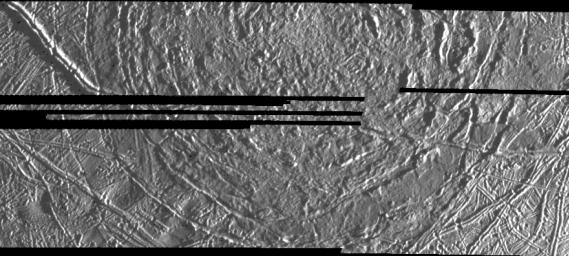
|
Macula on Europa
- Click the image above for a larger view
- Full-Res JPEG (880 x 396) (93.5 kB)
- Full-Res TIFF (880 x 396) (297.3 kB)
Caption:
This image of Europa, an icy satellite of Jupiter about the size of the Earth's Moon, was obtained from a range of 7415 miles (11933 kilometers) by the Galileo spacecraft during its fourth orbit around Jupiter and its first close pass of Europa. The image spans 30 miles by 57 miles (48 km by 91 km) and shows features as small as 800 feet (240 meters) across. The large circular feature centered in the upper middle of the image is called a macula, and could be the scar of a large meteorite impact. The surface of Europa is composed mostly of water ice, so large impact craters on Europa could look different from large bowl-shaped depressions formed by impact into rock, such as on the Moon. On Europa's icy surface, the original impact crater has been modified into a central zone of rugged topography surrounded by circular fractures which reflect adjustments to stress in the surrounding icy crust.
Background Info:
The Jet Propulsion Laboratory, Pasadena, CA manages the mission for NASA's Office of Space Science, Washington, DC.
This image and other images and data received from Galileo are posted on the Galileo mission home page on the World Wide Web at http://galileo.jpl.nasa.gov. Background information and educational context for the images can be found at http://www.jpl.nasa.gov/galileo/sepo .
Cataloging Keywords:
| Name | Value | Additional Values |
|---|---|---|
| Target | Europa | Jupiter |
| System | Jupiter | |
| Target Type | Satellite | Planet |
| Mission | Galileo | |
| Instrument Host | Galileo Orbiter | |
| Host Type | Orbiter | |
| Instrument | Solid-State Imaging (SSI) | |
| Detector | ||
| Extra Keywords | Crater, Grayscale, Impact, Moon, Water | |
| Acquisition Date | ||
| Release Date | 1998-03-06 | |
| Date in Caption | ||
| Image Credit | NASA/JPL | |
| Source | photojournal.jpl.nasa.gov/catalog/PIA00541 | |
| Identifier | PIA00541 | |
